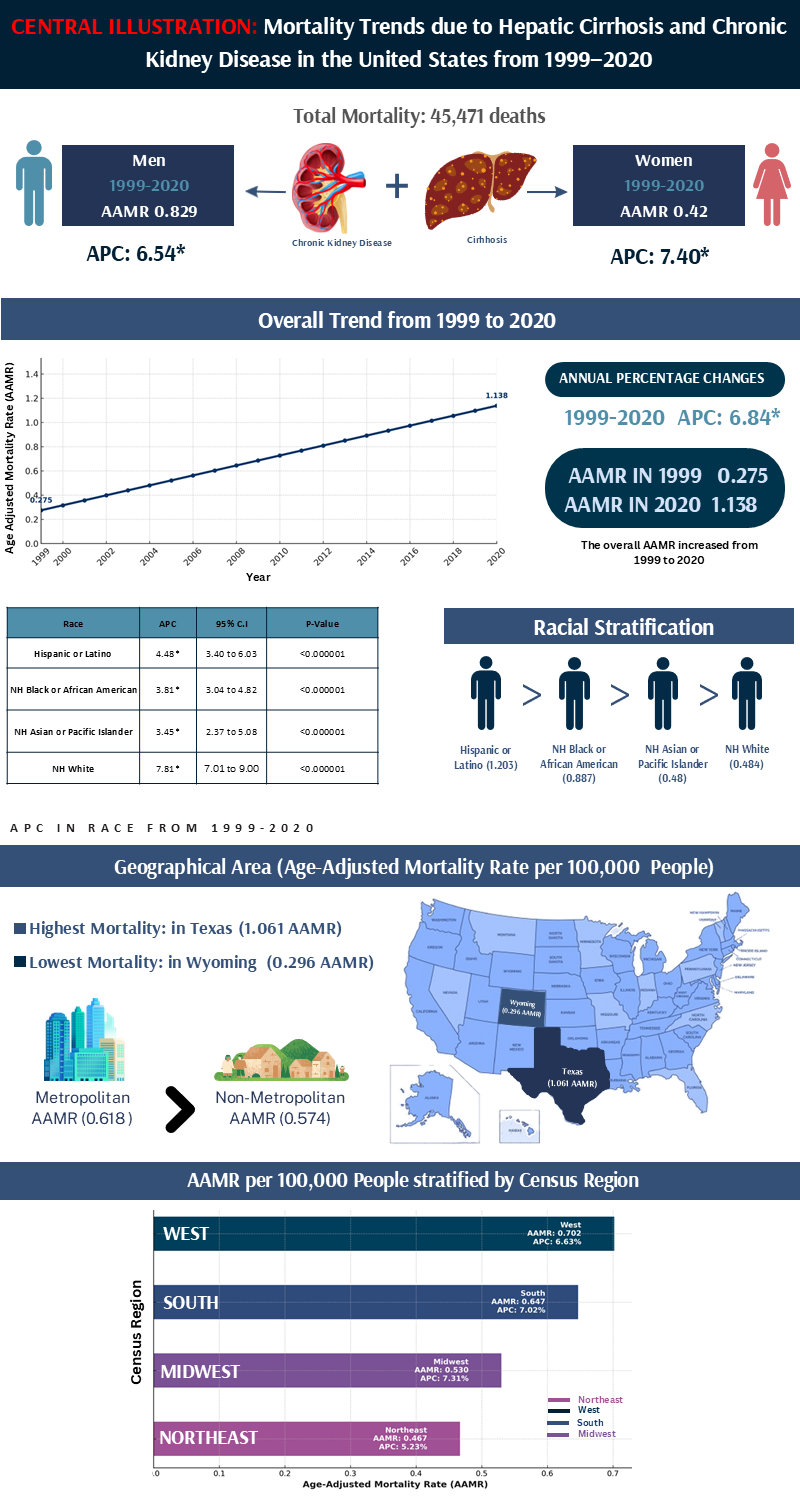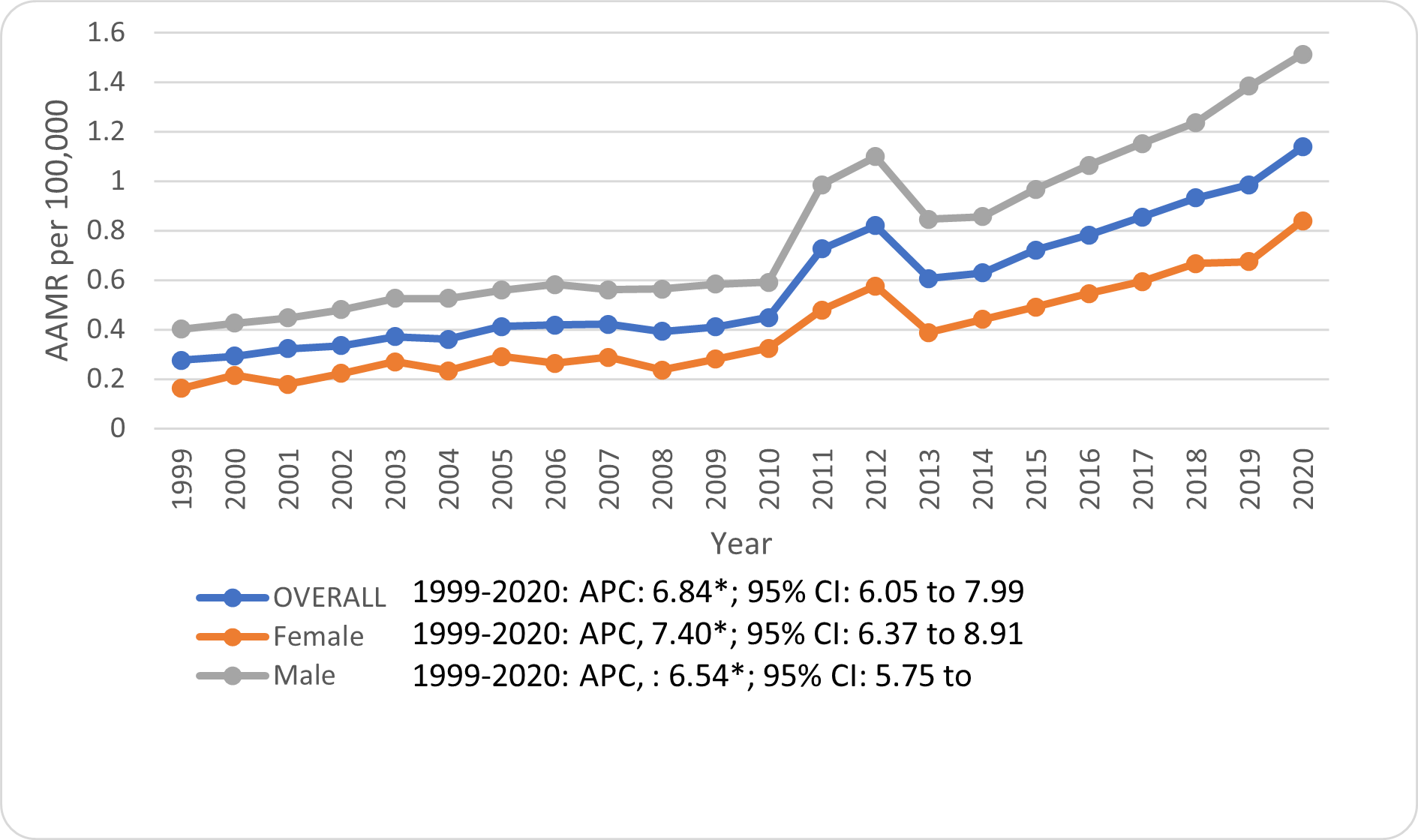Monday Poster Session
Category: Liver
P3794 - Mortality Patterns in Hepatic Cirrhosis and Chronic Kidney Disease: A US Population-Based Study (1999-2020)
Monday, October 27, 2025
10:30 AM - 4:00 PM PDT
Location: Exhibit Hall

Aisha Rehman Siddiqui, MD (she/her/hers)
Detroit Medical Center/Wayne State University
Detroit, MI
Presenting Author(s)
Mateen Ahmad, MBBS1, Aisha Rehman. Siddiqui, MD2, Ayman Irshad, MD3, Sahaab Noor, MBBS4, Humna Irshad, MBBS5, Muhammad Aliyan Ahmed, MBBS6, Noor-us-Sahar Siddiqui, MBBS7, Farina Siddiqui, MBBS7
1Jinnah Hospital Lahore, Lahore, Punjab, Pakistan; 2Detroit Medical Center/Wayne State University, Detroit, MI; 3Amna Inayat Medical College, Lahore, Punjab, Pakistan; 4Rawalpindi Medical University, Islamabad, Islamabad, Pakistan; 5Continental Medical College, Lahore, Punjab, Pakistan; 6Liaquat University of Medical and Health Science, Karachi, Sindh, Pakistan; 7Liaquat University of Medical and Health Science, Hyderabad, Sindh, Pakistan
Introduction: Hepatic cirrhosis and chronic kidney disease (CKD) frequently coexist, with each condition aggravating the other through shared inflammatory and hemodynamic mechanisms. In cirrhosis, portal hypertension compromises renal perfusion, heightening the risk of CKD. This study investigates annual mortality trends and demographic disparities associated with cirrhosis and CKD in the U.S. population from 1999 to 2020.
Methods: We analyzed cirrhosis-associated CKD-related mortality trends in the U.S. from 1999 to 2020 using the CDC WONDER Multiple Cause of Death database. Age-adjusted mortality rates (AAMRs) per 100,000 population were calculated. Temporal trends and annual percent changes (APCs) were evaluated overall and further stratified by sex, race/ethnicity, urban-rural classification, and U.S. census regions.
Results: Our analysis suggests that from 1999 to 2020, 45,471 cirrhosis-associated CKD-related deaths occurred among U.S. adults. The age-adjusted mortality rate (AAMR) increased from 0.27 to 1.14 per 100,000, with an annual percent change (APC) of 6.84% (95% CI: 6.05–7.98, p < 0.000001). Males had a higher AAMR (0.81) than females (0.42). Non-Hispanic American Indian or Alaska Natives had the highest AAMR (1.73), followed by Hispanics (1.2). Regionally, the West reported the highest AAMR (0.7). Metropolitan areas had higher rates (0.6) than non-metropolitan areas (0.5).
Discussion: Over the past two decades, mortality related to cirrhosis-associated chronic kidney disease (CKD) has steadily increased across the United States, highlighting significant disparities based on sex, race/ethnicity, and geographic location. The most substantial impact has been observed among non-Hispanic American Indian or Alaska Native populations, as well as individuals residing in the Western region. These disparities emphasize the urgent need for targeted public health initiatives aimed at reducing preventable deaths and promoting health equity among the groups that are disproportionately affected.

Figure: Overall and Gender stratified trends for Age-Adjusted Mortality Rates per 100,000 associated with Hepatic Cirrhosis and Chronic Kidney Disease, in the United States, 1999-2020

Figure: Trends in cirrhosis-associated CKD-related mortality in the U.S. (1999–2020), showing rising age-adjusted mortality rates overall. Stratified data highlight disparities by sex, race/ethnicity, region, and urbanization.
Disclosures:
Mateen Ahmad indicated no relevant financial relationships.
Aisha Siddiqui indicated no relevant financial relationships.
Ayman Irshad indicated no relevant financial relationships.
Sahaab Noor indicated no relevant financial relationships.
Humna Irshad indicated no relevant financial relationships.
Muhammad Aliyan Ahmed indicated no relevant financial relationships.
Noor-us-Sahar Siddiqui indicated no relevant financial relationships.
Farina Siddiqui indicated no relevant financial relationships.
Mateen Ahmad, MBBS1, Aisha Rehman. Siddiqui, MD2, Ayman Irshad, MD3, Sahaab Noor, MBBS4, Humna Irshad, MBBS5, Muhammad Aliyan Ahmed, MBBS6, Noor-us-Sahar Siddiqui, MBBS7, Farina Siddiqui, MBBS7. P3794 - Mortality Patterns in Hepatic Cirrhosis and Chronic Kidney Disease: A US Population-Based Study (1999-2020), ACG 2025 Annual Scientific Meeting Abstracts. Phoenix, AZ: American College of Gastroenterology.
1Jinnah Hospital Lahore, Lahore, Punjab, Pakistan; 2Detroit Medical Center/Wayne State University, Detroit, MI; 3Amna Inayat Medical College, Lahore, Punjab, Pakistan; 4Rawalpindi Medical University, Islamabad, Islamabad, Pakistan; 5Continental Medical College, Lahore, Punjab, Pakistan; 6Liaquat University of Medical and Health Science, Karachi, Sindh, Pakistan; 7Liaquat University of Medical and Health Science, Hyderabad, Sindh, Pakistan
Introduction: Hepatic cirrhosis and chronic kidney disease (CKD) frequently coexist, with each condition aggravating the other through shared inflammatory and hemodynamic mechanisms. In cirrhosis, portal hypertension compromises renal perfusion, heightening the risk of CKD. This study investigates annual mortality trends and demographic disparities associated with cirrhosis and CKD in the U.S. population from 1999 to 2020.
Methods: We analyzed cirrhosis-associated CKD-related mortality trends in the U.S. from 1999 to 2020 using the CDC WONDER Multiple Cause of Death database. Age-adjusted mortality rates (AAMRs) per 100,000 population were calculated. Temporal trends and annual percent changes (APCs) were evaluated overall and further stratified by sex, race/ethnicity, urban-rural classification, and U.S. census regions.
Results: Our analysis suggests that from 1999 to 2020, 45,471 cirrhosis-associated CKD-related deaths occurred among U.S. adults. The age-adjusted mortality rate (AAMR) increased from 0.27 to 1.14 per 100,000, with an annual percent change (APC) of 6.84% (95% CI: 6.05–7.98, p < 0.000001). Males had a higher AAMR (0.81) than females (0.42). Non-Hispanic American Indian or Alaska Natives had the highest AAMR (1.73), followed by Hispanics (1.2). Regionally, the West reported the highest AAMR (0.7). Metropolitan areas had higher rates (0.6) than non-metropolitan areas (0.5).
Discussion: Over the past two decades, mortality related to cirrhosis-associated chronic kidney disease (CKD) has steadily increased across the United States, highlighting significant disparities based on sex, race/ethnicity, and geographic location. The most substantial impact has been observed among non-Hispanic American Indian or Alaska Native populations, as well as individuals residing in the Western region. These disparities emphasize the urgent need for targeted public health initiatives aimed at reducing preventable deaths and promoting health equity among the groups that are disproportionately affected.

Figure: Overall and Gender stratified trends for Age-Adjusted Mortality Rates per 100,000 associated with Hepatic Cirrhosis and Chronic Kidney Disease, in the United States, 1999-2020

Figure: Trends in cirrhosis-associated CKD-related mortality in the U.S. (1999–2020), showing rising age-adjusted mortality rates overall. Stratified data highlight disparities by sex, race/ethnicity, region, and urbanization.
Disclosures:
Mateen Ahmad indicated no relevant financial relationships.
Aisha Siddiqui indicated no relevant financial relationships.
Ayman Irshad indicated no relevant financial relationships.
Sahaab Noor indicated no relevant financial relationships.
Humna Irshad indicated no relevant financial relationships.
Muhammad Aliyan Ahmed indicated no relevant financial relationships.
Noor-us-Sahar Siddiqui indicated no relevant financial relationships.
Farina Siddiqui indicated no relevant financial relationships.
Mateen Ahmad, MBBS1, Aisha Rehman. Siddiqui, MD2, Ayman Irshad, MD3, Sahaab Noor, MBBS4, Humna Irshad, MBBS5, Muhammad Aliyan Ahmed, MBBS6, Noor-us-Sahar Siddiqui, MBBS7, Farina Siddiqui, MBBS7. P3794 - Mortality Patterns in Hepatic Cirrhosis and Chronic Kidney Disease: A US Population-Based Study (1999-2020), ACG 2025 Annual Scientific Meeting Abstracts. Phoenix, AZ: American College of Gastroenterology.
